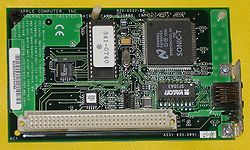
Processor Direct Slot
Encyclopedia

Apple Computer
Apple Inc. is an American multinational corporation that designs and markets consumer electronics, computer software, and personal computers. The company's best-known hardware products include the Macintosh line of computers, the iPod, the iPhone and the iPad...
, in several of their Macintosh models, provided a limited measure of hardware expandibility, without going to the expense (in both desktop space and selling price) of providing full-fledged bus
Computer bus
In computer architecture, a bus is a subsystem that transfers data between components inside a computer, or between computers.Early computer buses were literally parallel electrical wires with multiple connections, but the term is now used for any physical arrangement that provides the same...
expansion slots
Expansion slots
Expansion slots are specific slots on a PC motherboard that facilitate the placement of expansion cards.All such expansion slots are colour coded, and are built in such a way that only a specific type of card or device can interface with/ be inserted into the device.- Types :Common types of...
.
Typically, a machine would feature multiple bus expansions slots, if any. However, there was never more than one PDS slot. Rather than providing a sophisticated communication protocol with arbitration between different bits of hardware that might be trying to use the communication channel at the same time, the PDS slot, for the most part, just gave direct access to signal pins on the CPU.
Thus, PDS slots tended to be CPU-specific, and a card designed for the PDS slot in the Motorola 68030
Motorola 68030
The Motorola 68030 is a 32-bit microprocessor in Motorola's 68000 family. It was released in 1987. The 68030 was the successor to the Motorola 68020, and was followed by the Motorola 68040. In keeping with general Motorola naming, this CPU is often referred to as the 030 .The 68030 features on-chip...
-based Macintosh SE/30 would not work in the Motorola 68040
Motorola 68040
The Motorola 68040 is a microprocessor from Motorola, released in 1990. It is the successor to the 68030 and is followed by the 68060. There was no 68050. In keeping with general Motorola naming, the 68040 is often referred to as simply the '040 ....
-based Quadra 700.
The one notable exception to this was the PDS design for the original Motorola 68020
Motorola 68020
The Motorola 68020 is a 32-bit microprocessor from Motorola, released in 1984. It is the successor to the Motorola 68010 and is succeeded by the Motorola 68030...
-based Macintosh LC
Macintosh LC
The Macintosh LC was Apple Computer's product family of low-end consumer Macintosh personal computers in the early 1990s. The original Macintosh LC was released in 1990 and was the first affordable color-capable Macintosh. Due to its affordability and Apple II compatibility the LC was adopted...
. This was Apple's first attempt at a "low-cost" Mac, and it was such a success that, when subsequent models replaced the CPU with a 68030, a 68040, and later a PowerPC
PowerPC
PowerPC is a RISC architecture created by the 1991 Apple–IBM–Motorola alliance, known as AIM...
processor, ways were found to keep the PDS slot compatible with the original LC, so that the same expansion cards would continue to work.
Similarities to AGP
The Accelerated Graphics PortAccelerated Graphics Port
The Accelerated Graphics Port is a high-speed point-to-point channel for attaching a video card to a computer's motherboard, primarily to assist in the acceleration of 3D computer graphics. Since 2004 AGP has been progressively phased out in favor of PCI Express...
or AGP, which was the most widespread standard for connecting graphics cards to PC motherboards from 1997 until 2005, may be considered to be somewhere in-between a PDS and a bus. Like a PDS, there is no bus arbitration, so you can only have one AGP card per system; however, it works at a higher level than a PDS, in that it is CPU-agnostic, and AGP cards can be designed to work across Intel- or AMD-based PCs as well as Apple Macs and other computer platforms.
External links
- Pictures of several PDS cards at applefritter
- What kind of expansion or upgrade slots does my Mac have? at macfaq

